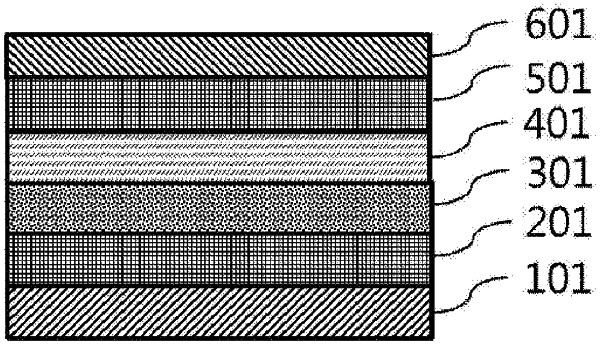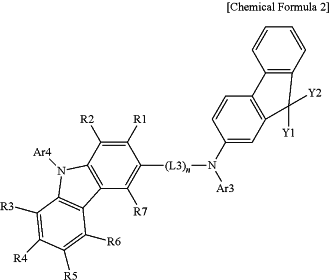| CPC H10K 85/654 (2023.02) [C07D 209/82 (2013.01); C07D 251/24 (2013.01); H10K 50/00 (2023.02); H10K 85/626 (2023.02); H10K 85/655 (2023.02); H10K 85/6572 (2023.02); H10K 99/00 (2023.02); H10K 50/11 (2023.02); H10K 50/15 (2023.02); H10K 50/155 (2023.02); H10K 50/156 (2023.02); H10K 50/16 (2023.02); H10K 50/165 (2023.02); H10K 50/17 (2023.02); H10K 50/171 (2023.02); H10K 85/30 (2023.02); H10K 2101/10 (2023.02); H10K 2101/40 (2023.02)] | 17 Claims |

|
1. An organic light emitting device comprising:
a cathode;
an anode provided opposite to the cathode;
a light emitting layer provided between the cathode and the anode;
a first organic material layer provided between the cathode and the light emitting layer, and including a cyclic compound represented by the following Chemical Formula 1; and
a second organic material layer provided between the anode and the light emitting layer, and including a carbazole derivative represented by the following Chemical Formula 2:
 wherein, in Chemical Formula 1,
Ar1 and Ar2 are the same as or different from each other, and each independently selected from the group consisting of hydrogen; deuterium; a nitrile group; a substituted or unsubstituted monocyclic or multicyclic hydrocarbon aryl group having 6 to 30 carbon atoms; and a substituted or unsubstituted monocyclic or multicyclic heteroaryl group selected from a thiophene group, a furan group, a pyrrole group, an imidazole group, a thiazole group, an oxazole group, a pyridyl group, a bipyridyl group, a pyrimidyl group, a triazine group, an acridyl group, a pyrazinyl group, a quinoxalinyl group, a pyrazinopyrazinyl group, an indole group, a benzoxazole group, a benzimidazole group, a benzothiazole group, a benzocarbazole group, a benzothiophene group, a dibenzothiophene group, a benzofuranyl group, a phenanthroline group, an isoxazolyl group, an oxadiazolyl group, a thiadiazolyl group, a phenothiazinyl group, or a dibenzofuranyl group;
m and n are 1;
X is carbon; and
G1 and G2 are the same as or different from each other, and each independently selected from the group consisting of hydrogen; deuterium; a nitrile group; a substituted or unsubstituted linear or branched alkyl group having 1 to 30 carbon atoms; a substituted or unsubstituted monocyclic or multicyclic cycloalkyl group having 3 to 30 carbon atoms; a substituted or unsubstituted monocyclic or multicyclic aryl group having 6 to 30 carbon atoms; and a substituted or unsubstituted monocyclic or multicyclic heteroaryl group having 2 to 30 carbon atoms, or G1 and G2 bond to each other to form a substituted or unsubstituted monocyclic or multicyclic aliphatic hydrocarbon ring; or a substituted or unsubstituted monocyclic or multicyclic aliphatic heteroring,
provided when both G1 and G2 are each independently a substituted or unsubstituted phenyl, Ar1 and Ar2 are each independently triazine group, a substituted or unsubstituted pyrimidyl group, or a pyridyl group unsubstituted or substituted with at least a nitrile group, wherein the triazine group is unsubstituted or substituted with at least one selected from deuterium; a nitrile group; a substituted or unsubstituted biphenyl group; a substituted or unsubstituted naphthyl group; a substituted or unsubstituted thiophene group; a substituted or unsubstituted quinolyl group; or a substituted or unsubstituted pyridyl group,
 in Chemical Formula 2,
Ar3 and Ar4 are the same as or different from each other, and are each independently hydrogen; deuterium; a substituted or unsubstituted monocyclic or multicyclic aryl group having 6 to 30 carbon atoms; or a substituted or unsubstituted monocyclic or multicyclic heteroaryl group having 2 to 30 carbon atoms;
L3 is a substituted or unsubstituted monocyclic or multicyclic arylene group having 6 to 30 carbon atoms;
n is an integer of 0 to 5;
when n is 2 or greater, the two or more L3s are the same as or different from each other;
R1 to R7 are the same as or different from each other, and each independently hydrogen; deuterium; a substituted or unsubstituted linear or branched alkyl group having 1 to 30 carbon atoms; a substituted or unsubstituted monocyclic or multicyclic aryl group having 6 to 30 carbon atoms; or a substituted or unsubstituted monocyclic or multicyclic heteroaryl group having 2 to 30 carbon atoms, or adjacent groups of R1 to R7 bond to each other to form a substituted or unsubstituted monocyclic or multicyclic hydrocarbon ring; and
Y1 and Y2 are the same as or different from each other, and each independently hydrogen; deuterium; a substituted or unsubstituted linear or branched alkyl group having 1 to 30 carbon atoms; a substituted or unsubstituted monocyclic or multicyclic aryl group having 6 to 30 carbon atoms; or a substituted or unsubstituted monocyclic or multicyclic heteroaryl group having 2 to 30 carbon atoms, or Y1 and Y2 bond to each other to form a substituted or unsubstituted monocyclic or multicyclic hydrocarbon ring.
|